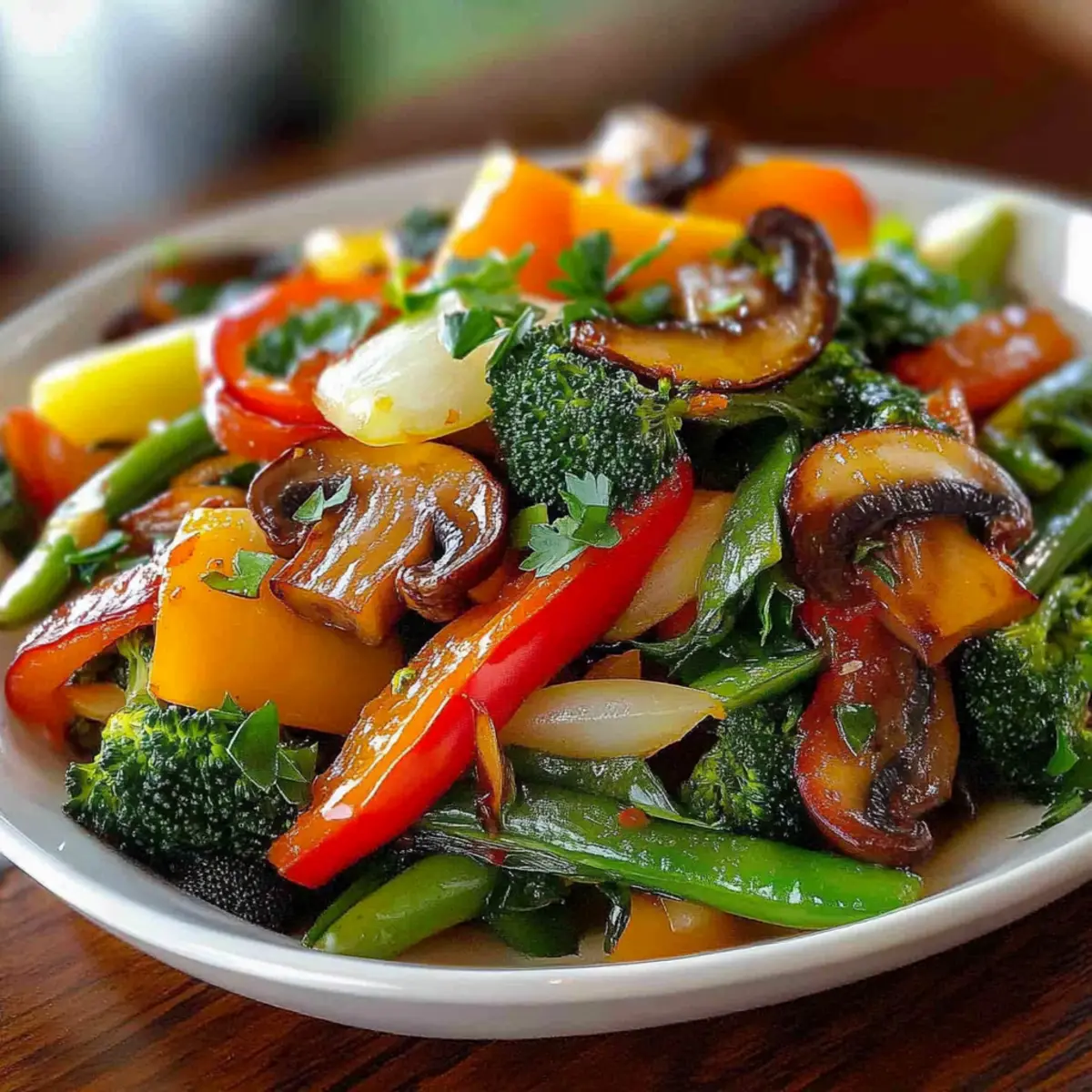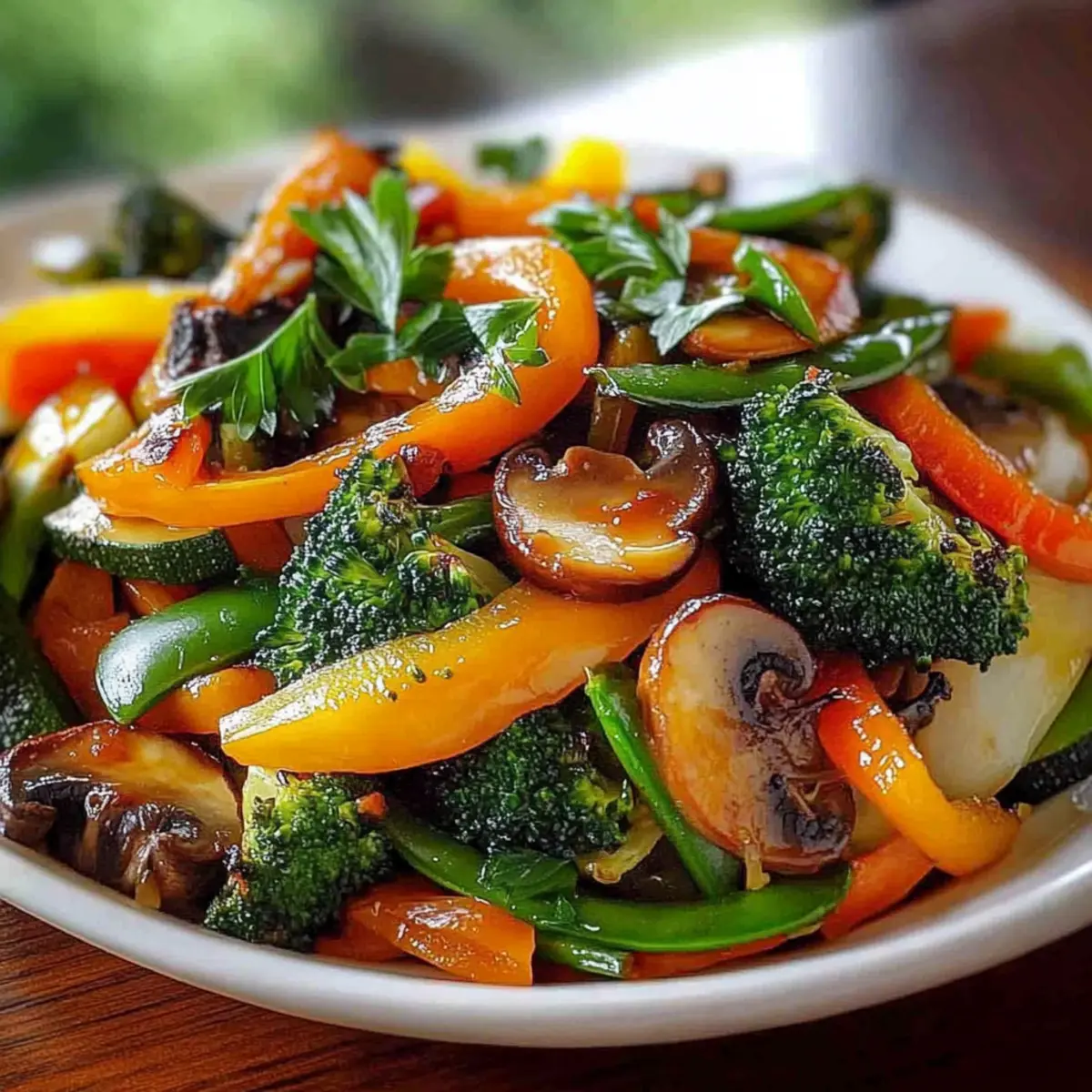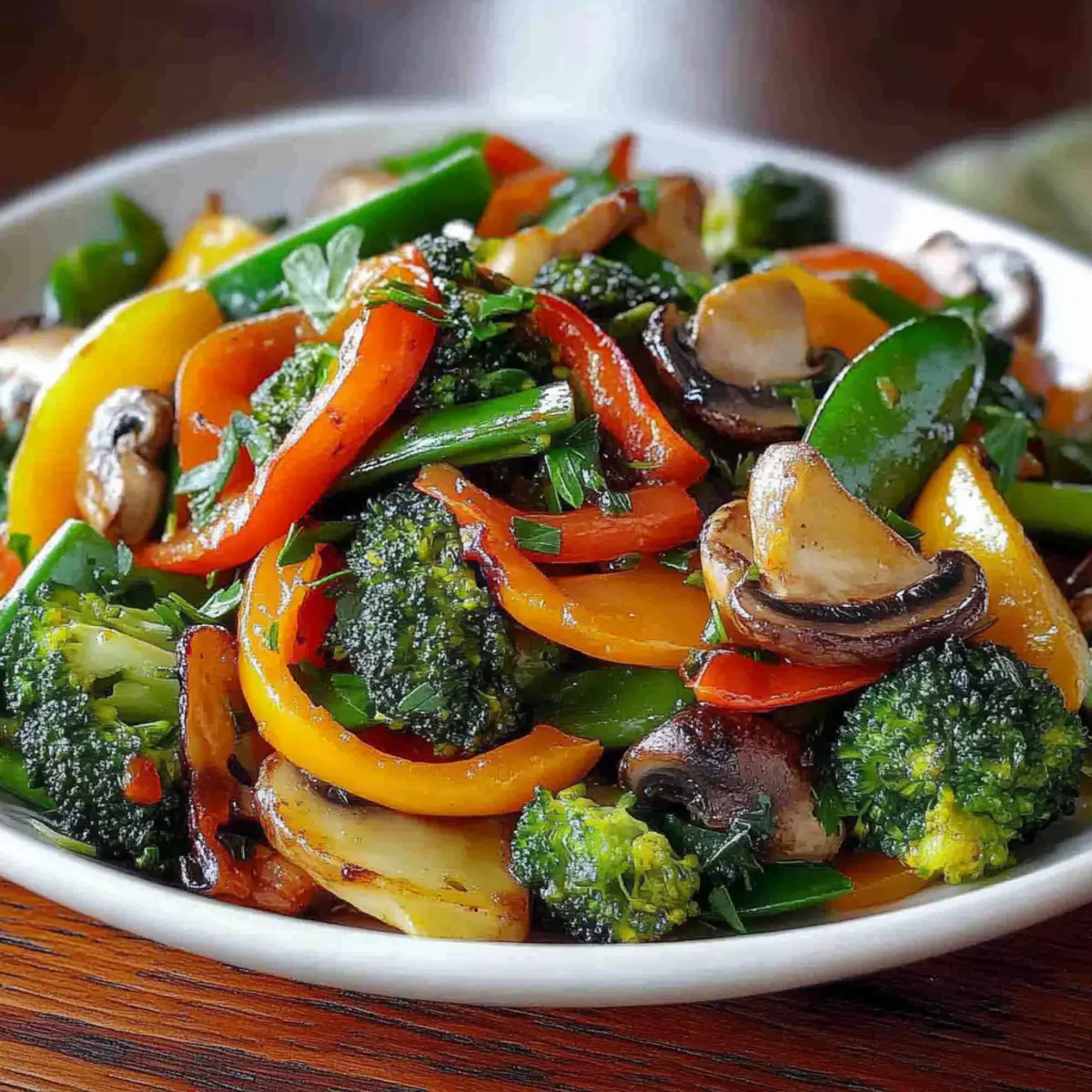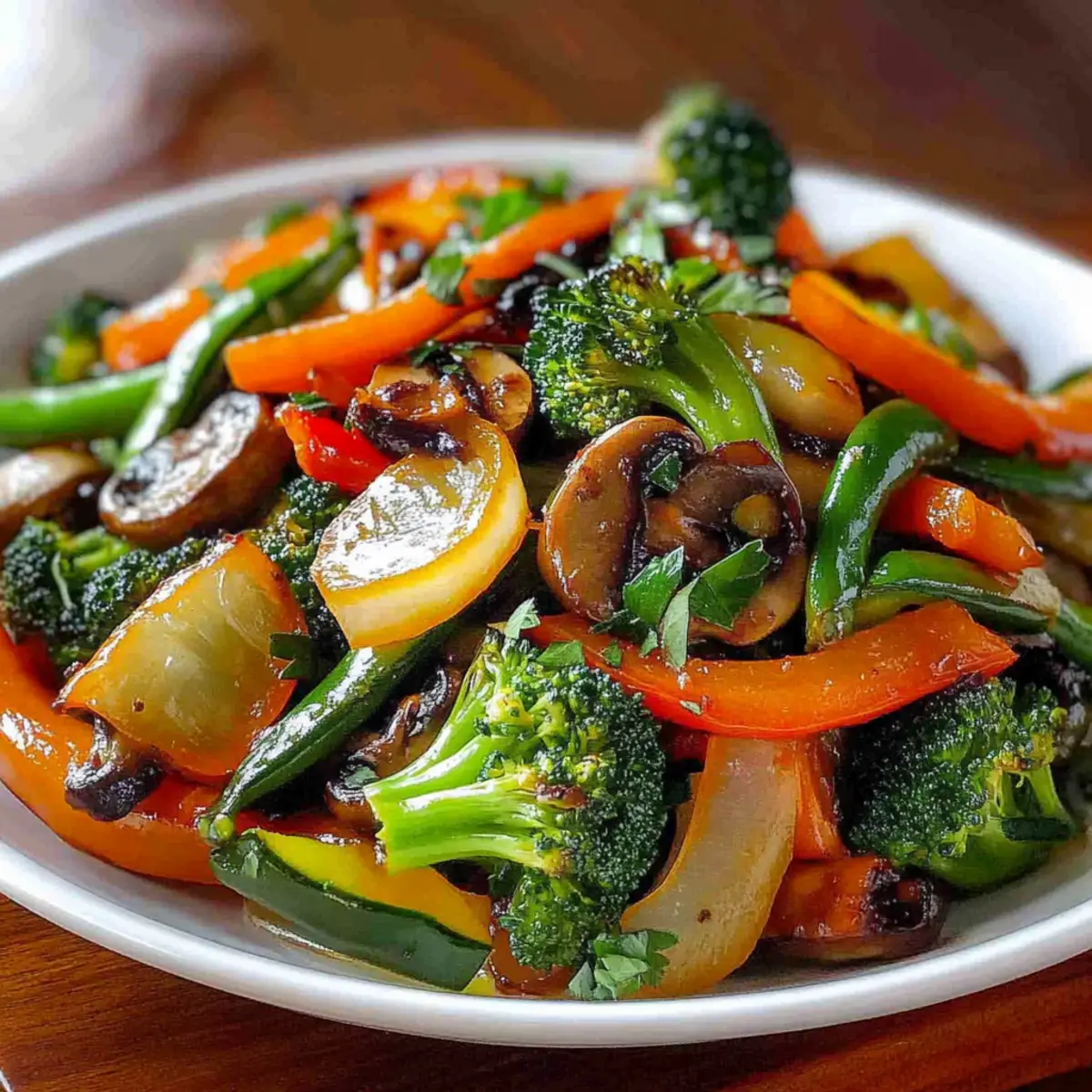As I tossed a medley of vibrant veggies into the skillet, the colors danced and sizzled, instantly transforming my kitchen into a lively palette of freshness. These Healthy Sautéed Vegetables are not just a dish; they’re the ultimate solution for busy weeknights when you crave something nutritious yet quick. With countless flavor variations, like Garlic-Parmesan and Mediterranean-inspired, you’ll discover endless ways to elevate this simple side. The best part? They’re not only packed with fiber and vitamins, making them a guilt-free addition to any meal, but they also invite creativity—relish in customizing each batch to suit your tastes. Ready to brighten up your dinner plate? Let’s dive into this delightful recipe!

Why Are Healthy Sautéed Vegetables a Must-Try?
Vibrant Colors: These sautéed vegetables not only taste great but also add a beautiful array of colors to your table.
Quick & Easy: Perfect for busy weeknights, this dish comes together in minutes, making dinner stress-free.
Endless Variations: Whether you’re craving a Garlic-Parmesan hit or a Mediterranean flair, customization is at your fingertips!
Nutritious Goodness: Packed with fiber and vitamins, every bite contributes to a balanced diet—guilt-free eating has never been this delicious!
Crowd-Pleasing: This dish is a surefire way to impress friends and family, satisfying even picky eaters. Serve it alongside your favorite proteins for a complete meal experience!
Feel free to explore your options, and don’t forget to check out our tips on meal prep and leftover storage for maximum efficiency!
Healthy Sautéed Vegetables Ingredients
For the Sauté
- Olive Oil (2 tbsp) – The perfect cooking medium to enhance flavors; can easily be swapped with avocado oil or butter.
- Garlic (2 cloves, minced) – Infuses aromatic goodness into the dish; ensuring even distribution for maximum flavor.
- Onion (1 small, thinly sliced) – Adds a hint of sweetness and depth; try shallots for a milder taste if preferred.
- Bell Pepper (1, sliced) – Brightens the dish with color and sweetness; use any variety depending on what’s in season.
- Zucchini (1, sliced into half-moons) – Light and tender; yellow squash is an excellent substitute if you want a change.
- Broccoli florets (1 cup) – Introduces crunch and nutrition; don’t hesitate to use frozen if you’re short on fresh!
- Carrot (1 medium, julienned or sliced thin) – Contributes a sweet and earthy flavor; cut evenly for consistent cooking.
- Snap Peas (½ cup) – Offers a crisp texture and slight sweetness; green beans also work beautifully in this mix.
- Mushrooms (½ cup, sliced) – Brings umami and moisture; feel free to use portobello or shiitake varieties for a twist.
- Salt and Black Pepper (to taste) – Essential seasonings to elevate flavors; always adjust to your palette preference.
For Optional Flavor Boosts
- Lemon Juice (1 tsp, optional) – Adds a zesty brightness; substitute with vinegar for a tangy twist if desired.
- Balsamic Vinegar or Soy Sauce (1 tsp, optional) – Introduces depth; choose based on the flavor profile you’re aiming for.
For Toppings
- Toasted Nuts or Seeds – Add crunch and more nutrients for an exciting textural contrast.
- Fresh Herbs – Elevates aroma and freshness; basil, parsley, or cilantro all make delightful additions.
- Grated Parmesan (optional) – A touch of savory richness to finish off your sautéed vegetables.
Enjoy crafting your Healthy Sautéed Vegetables with these vibrant ingredients that promise a delightful burst of flavor and nutrition!
Step‑by‑Step Instructions for Healthy Sautéed Vegetables
Step 1: Prep Vegetables
Begin by washing all your vegetables under running water, peeling if necessary. Thinly slice the onion, julienne the carrot, and chop the bell pepper into strips. Slice the zucchini into half-moons, and cut the broccoli into bite-sized florets. Lastly, slice the mushrooms and trim the snap peas. Ensure all pieces are uniform for even cooking, making your Healthy Sautéed Vegetables vibrant and appealing.
Step 2: Heat Pan
Place a large skillet over medium-high heat and allow it to preheat for about 2 minutes. Once hot, add the olive oil, swirling it around to coat the bottom of the pan. You’ll know it’s ready when the oil shimmers. This step is crucial to promote a good sauté that will infuse your Healthy Sautéed Vegetables with wonderful flavors.
Step 3: Cook Aromatics
Add the minced garlic and sliced onions to the skillet. Sauté them for 1–2 minutes, stirring frequently until the onions become translucent and garlic is aromatic. This step cores the flavor base for your Healthy Sautéed Vegetables, creating a delightful aroma that will have everyone anticipating the meal.
Step 4: Add Harder Vegetables
Introduce the julienned carrots and broccoli florets to the hot pan. Cook these for about 3–4 minutes, stirring often to ensure even cooking. You’ll want these vegetables to become tender but still maintain a slight crunch. This enhances the texture of your Healthy Sautéed Vegetables, enriching each bite with varied character.
Step 5: Add Softer Vegetables
Next, add the bell pepper, zucchini, mushrooms, and snap peas to the skillet. Sauté for another 4–5 minutes, mixing continuously until the veggies are crisp-tender and vibrant. Keep an eye on their color; they should look bright and glossy—this indicates freshness and optimal doneness for your Healthy Sautéed Vegetables.
Step 6: Season
Sprinkle salt and black pepper over the vegetable medley to enhance their flavors. If desired, add the lemon juice or balsamic vinegar to bring brightness and depth to the dish. Stir gently to combine all elements, ensuring an even distribution. This seasoning step is key to transforming your dish into irresistible Healthy Sautéed Vegetables.
Step 7: Finish & Serve
Toss the sautéed vegetables well for an even mix of flavors and textures. Remove from the heat and transfer to a serving dish. For an extra touch, garnish with your choice of toasted nuts, fresh herbs, or grated Parmesan. Serve immediately for the best flavor and texture, and enjoy the vibrant, nutritious explosion of your Healthy Sautéed Vegetables!

What to Serve with Healthy Sautéed Vegetables
Enhance your dining experience with flavorful accompaniments that complement the vibrant medley of sautéed veggies.
- Quinoa Salad: A light, protein-packed salad that adds texture and nutrition, making it a perfect partner for your vegetable medley. Toss in cherry tomatoes and cucumbers for extra freshness!
- Grilled Chicken: The smoky flavor of grilled chicken provides a hearty contrast, elevating your meal with a satisfying protein choice. It’s a classic combination that never disappoints!
- Rice Pilaf: Fluffy rice pilaf with herbs adds a comforting base that beautifully absorbs the delicious juices from the sautéed vegetables. Serve it alongside for a warm, hearty touch.
- Lemon Herb Couscous: Quick and zesty, this fluffy side dish brightens up the plate, keeping the meal light yet flavorful. The zestiness complements the sautéed veggies perfectly!
- Hummus and Pita: For a refreshing snack or appetizer, pair it with creamy hummus and warm pita. It adds variety while still aligning with your healthy theme.
- Roasted Salmon: The rich flavor of salmon pairs excellently with the crispness of your veggies, creating a well-rounded meal that feels indulgent yet healthy. Perfect for any night!
- Herbed Potatoes: Oven-roasted potatoes seasoned with fresh herbs provide a hearty texture and a comforting flavor that balances the lightness of sautéed vegetables. A wonderful comfort side!
- White Wine Spritzer: A light, refreshing drink that enhances your meal experience while underscoring the fresh flavors of your dish. Perfect for a relaxing dinner vibe!
Take these pairing ideas to elevate your family meals and impress your dinner guests!
Expert Tips for Healthy Sautéed Vegetables
- Don’t Overcrowd: To achieve the perfect sautéed texture, avoid overcrowding the pan. Cook in batches if necessary to allow the vegetables to sear properly.
- Start with Aromatics: Cooking garlic and onions first not only enhances the aroma but builds a flavorful base for your Healthy Sautéed Vegetables.
- Uniform Cuts: Ensure all vegetables are cut into similar sizes for even cooking. This prevents some from becoming mushy while others remain crunchy.
- Customize Wisely: Feel free to swap in seasonal vegetables or your favorites; just keep in mind that cooking times may vary for different types.
- Mind the Heat: Adjust the heat as needed. If vegetables start to burn, lower the temperature. Sautéing should produce a gentle sizzle, not a harsh crackle.
- Add Proteins: For a complete meal, consider tossing in pre-cooked proteins, like chicken or tofu, towards the end of cooking for a hearty twist!
Storage Tips for Healthy Sautéed Vegetables
Fridge: Refrigerate leftovers in an airtight container for up to 3–4 days. This keeps your Healthy Sautéed Vegetables fresh and ready for quick meals.
Freezer: For longer storage, freeze in an airtight container or freezer bag for up to 3 months. Make sure to cool them completely before freezing for best results.
Reheating: Reheat in a skillet over medium heat for a few minutes to maintain their crisp texture. Add a splash of water or broth to prevent drying out.
Make-Ahead: Consider chopping your vegetables in advance and storing them in the fridge for up to 2 days. This saves time and allows for fresh cooking when you’re ready to sauté!
Make Ahead Options
These Healthy Sautéed Vegetables are a fantastic choice for meal prep enthusiasts! You can chop all your veggies, such as bell peppers, zucchini, and broccoli, up to 24 hours in advance and store them in an airtight container in the refrigerator to maintain their crunch. When you’re ready to enjoy, simply heat your skillet, add the olive oil, and sauté your prepped vegetables along with the aromatics for about 10 minutes, ensuring they remain crisp-tender and vibrant. It’s a time-saving solution that allows you to bring delightful, nutritious flavor to your table on busy weeknights, all while keeping the quality just as delicious!
Healthy Sautéed Vegetables Variations & Substitutions
Feel free to get creative with these sautéed vegetables; they invite your own twist and flavor profile for a truly personalized dish!
- Dairy-Free: Omit Parmesan or use a plant-based cheese instead for a creamy touch without dairy.
- Asian-Inspired: Add soy sauce, sesame oil, and ginger to bring a delightful umami flavor to your vegetables.
- Mediterranean: Replace olive oil with a drizzle of lemon oil, and finish with feta cheese and fresh oregano for a taste of the Mediterranean.
- Spicy Kick: Add chili flakes or your favorite hot sauce for an extra layer of heat that makes each bite more exciting.
- Roasted Garlic: Roast garlic cloves instead of using minced, creating a sweeter, richer flavor that amplifies the dish’s warmth.
- Nutty Delight: Toss in some toasted almonds or pine nuts just before serving, enhancing texture and flavor with delightful crunch.
- Seasonal Veggies: Change up the vegetable mix based on the season—substituting with asparagus in spring or squash in fall creates new tastes every time.
- Herb Infused: Experiment with different fresh herbs like basil, thyme, or dill for a fragrant lift that elevates the entire dish.
Don’t forget to explore our tips on meal prep to plan ahead and leftover storage to keep your ingredients fresh and ready to enjoy!

Healthy Sautéed Vegetables Recipe FAQs
What is the best way to select ripe vegetables for sautéing?
Absolutely! When choosing vegetables, look for ones that are firm and vibrant in color. For example, select bell peppers that are glossy and free of dark spots, and choose broccoli with bright green florets. Ensure that zucchinis are smooth and unblemished. If you’re going for snap peas, they should feel crisp and snap easily. Freshness is key to achieving that delightful crisp-tender texture!
How should I store leftover sautéed vegetables?
I recommend refrigerating any leftovers in an airtight container for 3–4 days. This keeps them fresh and ready for your next meal! Remember to let them cool completely before sealing them up; it helps prevent any condensation that could lead to sogginess. Reheat quickly in a skillet for the best taste, retaining that vibrant texture.
Can I freeze sautéed vegetables, and how do I do it?
Yes, you can certainly freeze your Healthy Sautéed Vegetables! Just follow these simple steps: First, allow the cooked vegetables to cool completely. Then, transfer them to an airtight container or freezer bag, making sure to squeeze out any excess air. Label it with the date, and pop it into the freezer! They should stay fresh for up to 3 months. When ready to use, thaw in the fridge overnight or reheat straight from frozen in a skillet over medium heat.
What if my vegetables are soggy after cooking?
Very! If your sautéed vegetables turn out mushy, it may be because you overcrowded the pan initially or cooked them too long. To avoid this, make sure to cook in smaller batches so each vegetable can sear nicely without steaming. Another tip to keep them crisp is to start with the harder vegetables first, gradually adding the softer ones. If you want to salvage already soggy veggies, try sautéing them over high heat for a few more minutes to help reintroduce some texture!
Are there any dietary considerations for this recipe?
Definitely! This Healthy Sautéed Vegetables recipe is naturally vegan and vegetarian-friendly, making it a great choice for various diets. Just be cautious if you have allergies to specific vegetables like mushrooms or legumes like snap peas; there are plenty of substitutions you can make. For instance, you could replace snap peas with chopped green beans. If you plan to add any proteins, ensure they align with your dietary preferences as well.
Can I meal prep these early in the week?
Absolutely! I often chop my vegetables in advance and store them in the fridge, ready to sauté when I’m pressed for time. Just make sure you keep them in airtight containers and use them within 2 days for the freshest results! When you’re ready to cook, it only takes a few minutes to whip up this nutritious side. Happy cooking!

Savor the Flavor: Healthy Sautéed Vegetables Made Easy
Ingredients
Equipment
Method
- Begin by washing all your vegetables under running water, peeling if necessary. Thinly slice the onion, julienne the carrot, and chop the bell pepper into strips. Slice the zucchini into half-moons, and cut the broccoli into bite-sized florets. Lastly, slice the mushrooms and trim the snap peas.
- Place a large skillet over medium-high heat and allow it to preheat for about 2 minutes.
- Add the olive oil, swirling it around to coat the bottom of the pan.
- Add the minced garlic and sliced onions to the skillet. Sauté them for 1–2 minutes.
- Introduce the julienned carrots and broccoli florets to the hot pan. Cook these for about 3–4 minutes.
- Next, add the bell pepper, zucchini, mushrooms, and snap peas to the skillet. Sauté for another 4–5 minutes.
- Sprinkle salt and black pepper over the vegetable medley.
- Toss the sautéed vegetables well for an even mix of flavors and textures.
- Remove from the heat and transfer to a serving dish. Garnish with your choice of toasted nuts, fresh herbs, or grated Parmesan. Serve immediately.

Leave a Reply